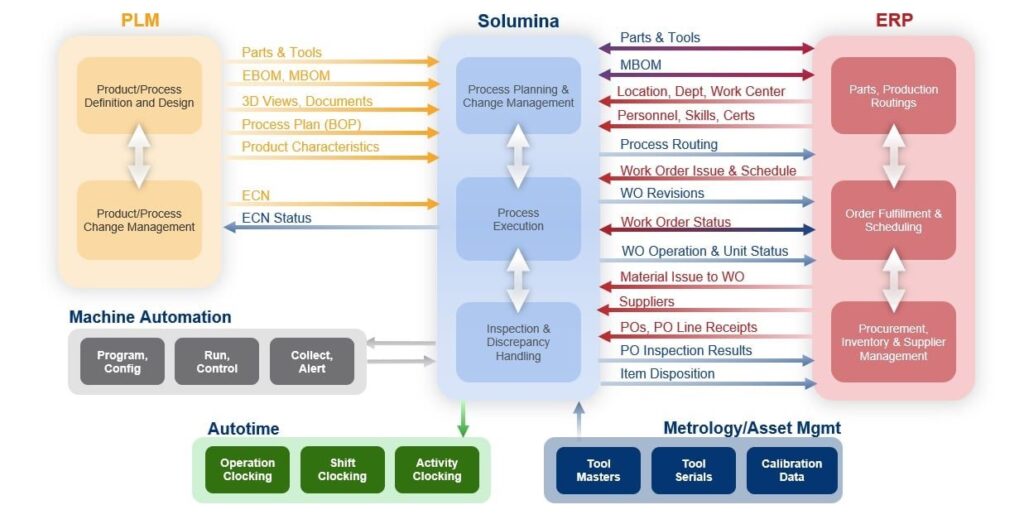We tend to think of digital transformation in terms of large, sweeping reforms, but sometimes it helps to think in more concrete terms. That’s because there are often practical, specific steps that manufacturers can take now to improve operations, even apart from the advantages of larger transformation initiatives.
One such step that should be high on every manufacturer’s list is the integration of Product Lifecycle Management (PLM) and Manufacturing Execution Systems (MES). There are good reasons to integrate these systems even without further transformation plans. The fact that PLM-MES integration is a key building block on the way to digital threads and smart factories is a great bonus.
Let’s take a brief look at why this step is so important, and then we’ll see how it can lead to even bigger things.
At the center of manufacturing
Along with ERP and PLM, MES forms the digital backbone of a manufacturer’s business, executing real-time operations on the shop floor. Yet in many companies today, information between PLM and MES is still being transferred manually. There may be some connectivity, but it is typically limited to the essential integration points.
One reason that integration has been so challenging is the sheer number of connections where data should be moving. The accompanying chart illustrates the point well. If anything, it leaves out some possible connections. Note how all three enterprise systems interact repeatedly throughout the planning, execution, and accounting process.
Manual data transfer can’t possibly keep up with all of this activity, and so valuable information gets lost or wasted. Not to mention the problem of lost time and human error. Maybe most importantly, siloed data is not dynamic and never can be. Without MES integration, PLM is basically an event log—able to tell you what happened, but not able to help you in real time.
The value of connectivity
Connecting all the integration points in the graphic above—digitally implemented and automatic, with no manual data input—has a powerful impact on operations. It improves efficiency, accuracy, and timing.
With full connectivity, you can take advantage of things like automated data publishing, real-time communication between departments, improved error reporting, and full product histories. There are also operational gains, such as being able to implement and maintain your information systems with fewer people, removing data duplication, and having one version of product information for people to work with at all times.
These are all significant benefits that make the integration project worth doing in its own right. But as I mentioned above, there’s more to the story.
Thinking bigger: the Model-based Enterprise
PLM-MES integration is one of the fundamental steps on the way to smart factories, digital threads, and the Model-Based Enterprise. Once MES and PLM are tightly linked, big things can happen.
The Model-based Enterprise, or MBE, is an important subject in its own right and you can read more about it here, but I want to cover it briefly now because it’s the icing on the cake. MBE refers to an enterprise that is able to use an annotated 3D digital model of the product as the single, authoritative information source at every stage of the product’s lifecycle. It begins with the 3D model created in design engineering and is then carried through the full manufacturing process and beyond, available to all users at all times.
I want to emphasize that this 3D model is not merely a graphic effect or pretty picture. It is a complete representation of the product including components, assemblies, and histories. What’s more, it’s a dynamic model that is always in sync with the actual, physical product it represents. This has game-changing benefits, such as:
- Reduces time to market by more accurate modeling of parts and processes
- Lowers production costs through improved tool design and fabrication, fewer overall assembly hours, and less rework
- Streamlines new product development and introduction by enabling collaboration, managing engineering change orders, and easing testing and QA process
- Enables digital continuity across entire product life cycle
Ultimately, the Model-Based Enterprise is the foundation for digital threads and truly smart factories—in other words, full digital transformation.
Developing a Smart Factory, one step at a time
We’ve gone pretty far from the PLM-MES connectivity we started this discussion with, and that’s the point. That’s why this essential integration should be high on every manufacturer’s to-do list: because it’s easily justified in its own right and at the same time, it leads to much bigger things.
PLM-MES is at the top of our to-do list at iBase-t. The newest release of Solumina MES iSeries includes many out-of-the-box integrations with PLM, as well as standard APIs that require little or no custom coding. More integration solutions are in the works, too. Along with the ability of Solumina iSeries to be deployed over the cloud, this makes it possible for even smaller manufacturers to get the benefits of digital transformation—starting with one of the most important first steps, PLM-MES integration.





